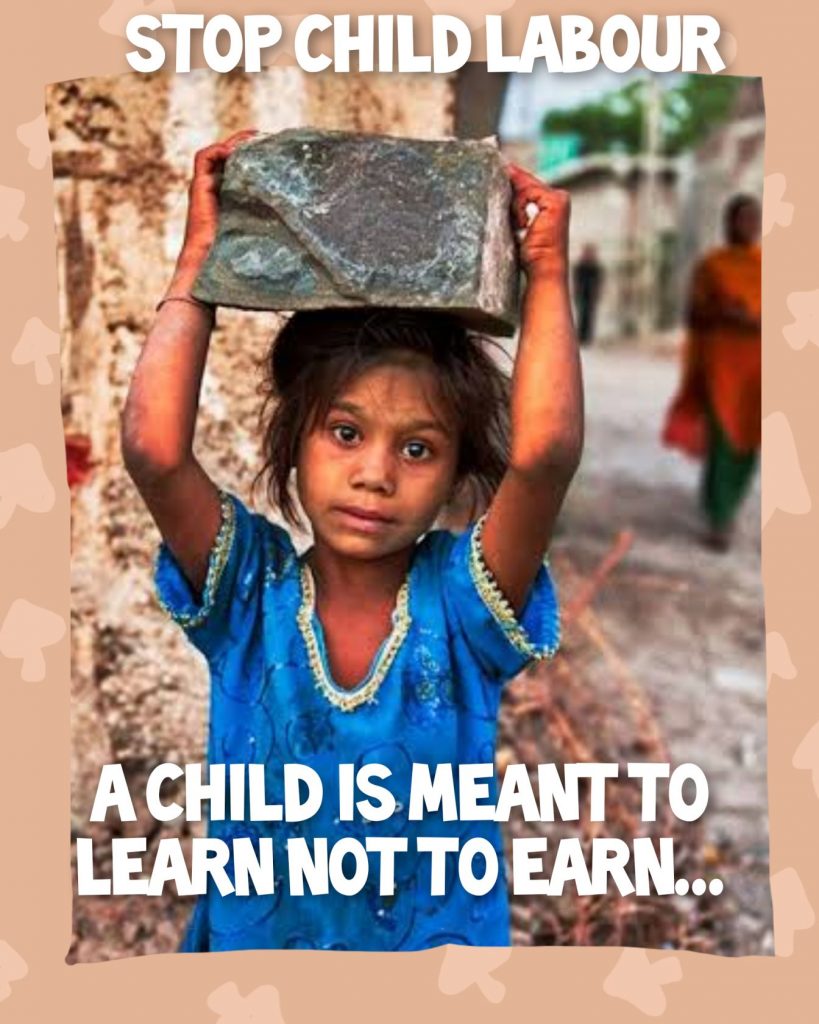
Overview
One of the most important human rights concerns facing the world today is child labor. The International Labour Organization (ILO) estimates that 160 million children work as children worldwide, with almost half of them doing so in dangerous jobs. Child labor keeps kids stuck in a cycle of exploitation and poverty by robbing them of their childhood, education, and future opportunities.

A multifaceted strategy involving governments, corporations, communities, and individuals is needed to eradicate child labor. This article examines the underlying causes of child labor, its effects, and practical measures that can be taken to end it.
Knowing the Causes and Effects of Child Labor
The underlying causes of poverty and child labor Extremely poor families frequently depend on the income of their children to survive.
Lack of Education: Children who have limited access to high-quality education are forced to work rather than attend school.

Weak Labor Laws: Child labor laws are not adequately enforced, which permits exploitation to continue.
Demand for Cheap Labor: Some industries, such as mining, textiles, and agriculture, take advantage of children for meager pay.
Cultural Norms: Child labor is difficult to eradicate in some societies because it is accepted as normal.
Physical and Mental Harm: Children who work in dangerous jobs experience illnesses, injuries, and psychological trauma as a result of child labor.
Education Loss: Children who work miss school, which restricts their options in the future.
How Can Child Labor Be Prevented?
- Make laws stronger and enforce them
Governments need to:
Enact stringent legislation against child labor and impose harsh sanctions on offenders.
To guarantee compliance, conduct more workplace inspections.
Accept international agreements such as the Worst Forms of Child Labor Convention (No. 182) and the ILO’s Minimum Age Convention (No. 138).
- Expand Educational Access
All children should have access to free and mandatory education.
Incentives (such as free meals or books) and scholarships can promote attendance at school.
For older kids, vocational training can offer alternatives to exploitative labor.
- Assist Low-Income Families
Programs for cash transfers can assist families in meeting their basic needs without resorting to child labor.
The creation of adult jobs guarantees that parents can provide for their families.
Microfinance programs enable families to launch small enterprises.
- Increase Knowledge and Modify Social Conventions
Parents can learn about the risks of child labor through community campaigns.
Advocacy and the media can draw attention to the problem and exert pressure on decision-makers.
Cultural acceptance of child labor can be changed by interacting with local and religious leaders.
- Corporate Responsibility and Ethical Consumerism
Steer clear of items like chocolate, clothing, and carpets that were produced using child labor.
Encourage ethical and fair-trade companies that guarantee supply chains free of children.
Demand that businesses be open and honest about their labor practices.
- Assist advocacy groups and NGOs
Companies such as:
UNICEF
Preserve the Children
The Global March Against Child Labor seeks to change laws, rescue children, and educate the public. Volunteering or making a donation can have an impact.
- Encourage Kids to Speak Up
Abuse and exploitation can be reported to child helplines.
Children can learn about their rights through youth programs.
Children are encouraged to help one another through peer education.
Achievements in the Battle Against Child Labor
In certain areas, conditional cash transfers under Brazil’s Bolsa Família Program decreased child labor by 40%.
The Right to Education Act of 2009 in India reduced child labor by making education mandatory and free.
Thousands of children have been saved by RugMark Certification (now GoodWeave), which guarantees carpets are free of child labor.
What Are You Able To Do?
You can:
✅ Inform yourself and others about child labor as an individual.
✅ Encourage moral companies and shun exploitative ones. Volunteer or make a donation to organizations that fight child labor.
✅ Speak with legislators to support stricter legislation. Inform authorities or non-governmental organizations about suspected child labor.
In conclusion
Governments enforcing laws and consumers making moral decisions must work together to end child labor. Despite advancements, millions of children continue to endure exploitation. Every child can have their right to a safe and happy childhood if we promote ethical behavior, education, and the fight against poverty.
Now is the moment to take action. By working together, we can end child labor and give every child a better future.
References
- International Labour Organization (ILO)
- UNICEF
- Global March Against Child Labour
- World Bank Reports on Child Labour